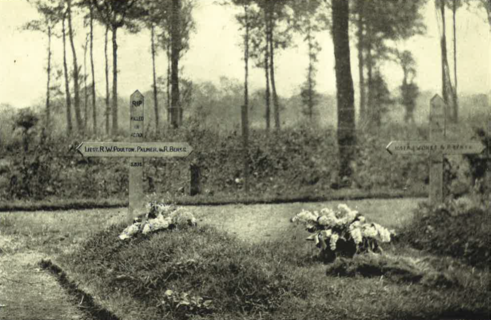We lost Ronnie Poulton on May 5th 1915, and just after Christmas, some three and a half years later, Professor Edward Poulton has been able for the first time to visit his son’s grave.
We are most grateful to him for sending in this for the next edition of the ‘Draconian‘:
“The photograph of Ronald’s grave, taken by Capt. GM Gathorne-Hardy MC (4th Berks) and here reproduced, represents the original Cross erected after the funeral on May 6th 1915…
A year and a quarter later, Ronald’s Marlston friend, the Rev Frank Ford CF, replaced the original Cross by one of greater strength. It so happened that another friend, Capt. E Whitnall, was passing at the time, and his memories convey a striking and accurate picture of the spot:
‘On the 18th (August 1916) I was bicycling along the bumpy pavé which leads from the dead ruins of Ploegsteert village, with the shattered red brickwork of its church, along the straight, tall avenue to the foot of Hill 63, where the Messines Road turns and rises to the right…
At the parting of the roads, at the foot of the hill was a notice board, ‘Hyde Park Corner.’ Short of this, close to the edge of the road and lying in part of Ploegsteert Wood itself, was a little cemetery of neatly arranged brown wooden crosses…
At the very moment of passing I turned my head at seeing two men replacing one simple cross by another – as simple, but painted white – and caught the name. An officer of the 3rd Hussars with me exclaimed, ‘Why, that’s the name of a fellow I was with at Rugby!’ and so we helped…
A year later the second Cross, much splintered by shell fire, was replaced by my son-in-law, Capt. CP Symonds RAMC, who erected the strong and heavy oak Cross which still remains.
The cemetery passed into the possession of the enemy for some months last year, but Capt. Symonds was able to write, on October 24th, 1918:
‘I visited dear Ronald’s grave this afternoon, and am so glad to be able to tell you that it is almost exactly as I left it this time last year. The oak Cross is standing intact save for two small scratches, and the grave itself is quite tidy; in fact the whole cemetery seems to have suffered very little during the past year, in spite of its having twice changed hands. It was a very different scene from that on my last visit – no sounds or sights of active war – only the scars of the past.’
I visited the grave on December 20th, and found it uninjured, just as Capt. Symonds describes, although there are several large shell holes full of water within a few feet of it and most of the trees seen in the photograph have been destroyed…
On his grave a cowslip was growing, planted, I am sure, by loving hands.”
Professor Poulton is compiling a book on Ronald’s life, which he hopes to publish later this year.
* * * * * *
The ‘In Memoriam column’ in the ‘Times’ today carries the name of Martin Collier, for whom no grave was possible. He was lost exactly a year ago, in the vastness of the North Sea.


I find these articles fascinating. They remind us that the war didn’t end for everyone November 11, 1918. Was Martin Collier related to Elspeth Collier who lived at one time on Garford Road?
LikeLike